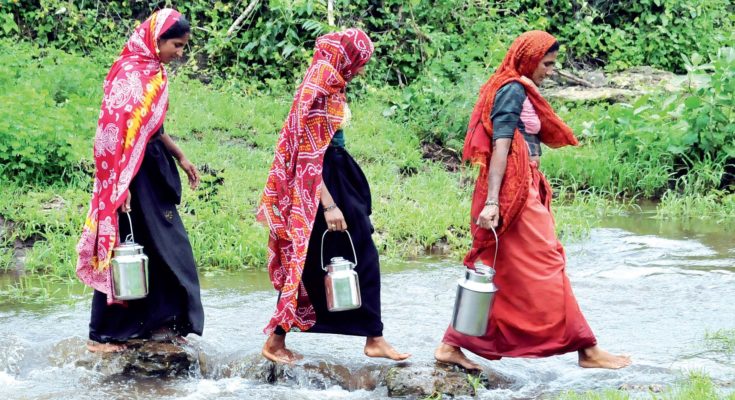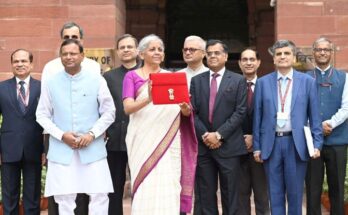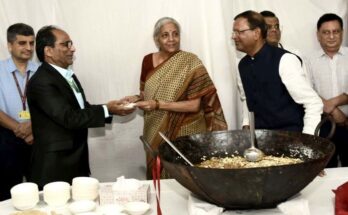COVID-19 was declared a pandemic by World Health Organization (WHO) on March 11, 2020 and since then there is a state of emergency across the globe. The disease and the restrictive measures imposed to control it brought the entire global economy to a halt and a worst recession since the Great Depression of 1930s is well on the cards. The crisis has affected not only the lives of people but has taken a heavy toll on their livelihood also. Though, agriculture for India is being seen as a saviour in this crisis but the sector has also not remained completely buoyant. Lockdown and breakdown of supply chain affected more or less every sector within agriculture. However, the effect was more conspicuous in the case of high-value and perishable commodities like flowers, meat, dairy, poultry, fruits and vegetables.
Dairy sector which contributes around 26 per cent to total agriculture GDP of India and provides livelihood to millions of household was already struggling due to rising input cost during 2019 and the COVID-19 further aggravated it. On the one hand, the input cost further increased due to supply issues and on the other there was a dip in demand of dairy products due to closure of hotels, restaurants and cafeteria (HoReCa). Now, majority of the supply issues in the dairy sector have been resolved with relaxations in lockdown restrictions and re-starting of economic activities but the after-effects of supply chain disruption during lockdown period will be visible in the post-lockdown phase. In addition, demand uncertainties are here to stay for a longer time. Thus, post lockdown period pose new challenges for the dairy sector.
The prices of cattle feed and dry fodder increased by 20-30 per cent during lockdown and the dairy farmers who were not able to meet the increased expenditure fed lesser feed and fodder to their animals. In the short-term, this resulted in lower milk production but it will have long-lasting repercussions for dairying as poor nutrition also affects the animal health. Similarly, missed Artificial Insemination (AI) which was mostly due to irregular supply of frozen semen will lead to diminished calving rate. Both the factors will negatively affect the income of the dairy farmers in near future. Net income of dairy farmers tumbled even during lockdown due to fall in sales and higher cost of milk production. The private processors stopped procurement of milk in the lockdown period owing to drop in demand. However, cooperatives tried their best to procure all the milk from farmers but most of them had to reduce the procurement price by 10 to 30 per cent. Lower income of dairy farmers during and after lockdown period will further hinder the farm investment in near future. Another major challenge for the dairy farmers is to sell the ghee which was prepared from surplus milk during lockdown, before it gets spoiled.
Likewise, inventories of Skimmed Milk Powder (SMP), white butter, ghee and UHT milk are high in processing plants too and clearing them within time at remunerative prices is a major task. Prices of SMP are already 16-17 percent lower than the last year. Moreover, though India didn’t sign Regional Comprehensive Economic Partnership (RCEP), but recently it has allowed import of 10,000 MT of milk and milk products at a concessional import duty of 15 per cent owing to the WTO commitments. This move can further aggravate the woes of dairy industry since the market is already overburdened with SMP stocks.
Revenue of most of the dairy processing units shrank significantly during the lockdown and they are running short of working capital. Specifically, units producing ice-cream and milk based beverages completely lost their business during the lockdown and they will need proper support for revival. Dairy farms and processing plants are also struggling with non-availability of labours for some time as most of them have migrated back.
A major onus of recovery of the dairy sector lies on the demand side. Demand uncertainties are likely to continue for a much longer time as the pandemic has still not shown any sign of slowing down. Though, most of the economic activities have resumed and people are back at their workplace but we can’t expect a quick retrieval of demand of dairy products to pre-COVID level as the infection cases are still raising and people will hesitate in consuming outside food. Moreover, certain restrictions are still in place for big social gatherings like marriage, parties along with social gatherings which forms a considerable share in the demand of dairy products. People even on their own will continue to avoid crowded places due to fear of infection, thus, leading to sluggish growth in demand.
In addition to fear of infection, decline in the household income can further affect the demand. Many people lost their source of livelihood during lockdown or had to face a pay cut. This combined with approaching recession further enfeeble the chances of quick revival as dairy products are elastic and fall in the income of consumer directly affects their demand. Significant reduction in the household demand for milk (-2.06%), paneer (-18.35%), butter (-11.86%) and ice-cream (nil consumption in 75% of respondent households) during lockdown was clearly evident in one of our online survey which collected data from around 1000 respondents spread across the country. The fall in demand was more in the urban areas and among the lowest income class. This indicates that already distressed people were affected more. This also raises the concern about nutritional security of urban poor as milk serves as an important source of protein for majority of the Indian population. Other than this, post lockdown demand of dairy products in urban areas will also depend on the return of migrant labours.
Besides domestic demand we can’t expect much from global demand also as all the countries are facing similar crisis. The top five export destinations of Indian dairy products are Turkey, UAE, Bangladesh, Egypt and Bhutan. Due to COVID-19 and its effect on the economy most of the countries are focusing on protectionism and uplifting and supporting local producers. The Arab countries have faced dual attack on the economy due to oil market crash and the virus crisis. Thus, revival of these economies will also be gradual. Apart from different price shocks dairy sector received in Bangladesh since 2008, COVID-19 has posed additional problems for the dairy farmers. During lockdown, 12-15 million liters of milk per day remained unsold in Bangladesh. In such circumstances, too much expectation from exports is not reasonable.
With stockpiling of dairy products, additional storage cost, crashing global prices, lower demand and unwaning infection cases, Indian dairy sector is facing multiple uncertainties. The question that now arises is whether the sector will be able to timely absorb these shocks and still its answer is quite ambiguous. Revival of demand in the post lockdown phase is necessary for the sector which in turn depends on subsidence of the pandemic and overall recovery of the economy. Till then appropriate support both for producers and processors will be required. Government has recently announced an interest subvention up to 4 percent on working capital loans for dairy sector which can help the cooperatives and producer organisations in making timely payments to the farmers. Other initiatives like Animal Husbandry Infrastructure Development Fund and support for vaccination programme will further help in improving the resilience of the sector in near future. Apart from this, the pandemic crisis has taught other important lessons like utilisation of locally available resources for feed and fodder which will not only reduce the cost but can also prove quite helpful in the event of any supply chain disruption. Some of the dairy consumers (5.60%) switched to online ordering during lockdown.
Strengthening of alternative marketing channels like e-marketing and doorstep delivery for dairy products can help in arresting the drop in their demand to some extent during any such pandemic or in case if there are subsequent waves of this pandemic. There was a small but clear shift (9.98% of respondents) towards packaged dairy products also which indicates the growing concern about food safety. In every crisis lies an opportunity which we have to seize and meanwhile, recovering economy will simultaneously boost the dairy sector.
(Dr. Gunjan Bhandari is a scientist at Dairy Economics, Statistics and Management Division, ICAR-National Dairy Research Institute, Karnal, Haryana and Priyanka Lal is a Ph.D. scholar a the institute. Views expressed in the article are authors’ own.)





Helpful ✅